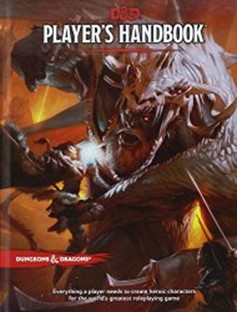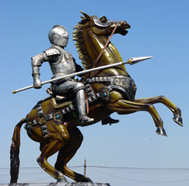 The early days of AD&D 2nd Edition were a time for a lot of experimentation with how to create characters. The introduction of Non-Weapon Proficiencies into the game with the last few supplements of 1st Edition had been embraced by the designers of 2nd Edition. As a nod to backwards compatibility, they were described as “Optional”, but most of the upcoming character supplements, the “PHBR” or “Complete Handbook” line pretty much assumed their use.
The early days of AD&D 2nd Edition were a time for a lot of experimentation with how to create characters. The introduction of Non-Weapon Proficiencies into the game with the last few supplements of 1st Edition had been embraced by the designers of 2nd Edition. As a nod to backwards compatibility, they were described as “Optional”, but most of the upcoming character supplements, the “PHBR” or “Complete Handbook” line pretty much assumed their use.
The first of this line, the Complete Fighter’s Handbook, was a pretty good book. Apart from introducing a lot of interesting manoeuvres that could be used in combat by everyone, it also introduced the concept of Kits, which were basically ways of customising your character around a certain theme. Later editions would have their own takes on customising characters in ways reminiscent of kits: 3E had Prestige Classes, PF has Archetypes, and 5E has Backgrounds and Paths.
Kits also gave rise to the understanding that “roleplaying penalties are not sufficient balance for mechanical bonuses”, something that was taken very seriously by the 3E design team. By which you can understand that the 2E design team weren’t aware of it, so many of the kits were terribly unbalanced. Especially those in the Complete Book of Elves. If you ever see an older player with a hatred of elven power-gamers, it’s probably because of that book. Not all kits were overpowered. There were a lot that you wouldn’t even notice a character having, they were so underpowered…
However, even when the mechanical implementation was bad, the idea behind the kits was still a good one. Obviously Mike Mearls thinks so, because he’s reimagined several of the kits into new class options for the fighter and bard. Let’s have a look at the inspiration behind these options, and a little look at how they’ve been implemented.
Fighter: Cavalier
 Original Source:
Original Source:
Complete Fighter’s Handbook, Cavalier
Original Mechanics: Gained proficiency in horse riding and etiquette. Gains bonuses to hit with lance, swords, and a horseman’s weapon (mace, flail or pick) from +1 to +3. Immune to fear. +4 bonus to save vs mind-affecting magic. Begins play with free warhorse. +3 reaction adjustment, except -3 from evil characters. The right to require shelter. Drawbacks: Cannot attack at range if he can charge instead. Must attack the most powerful opponent. Must wear best form of armour. Must follow code of chivalry or lose bonuses.
The Complete Fighter’s Cavalier was the 2E take on one of the most problematic classes of 1E’s Unearthed Arcana. In UA, Gygax decided to balance a completely over-powered class with a bunch of restrictions on combat that were mostly impossible to follow in most campaigns. The Complete Fighter’s version got rid of some of the most overpowered traits (increasing ability scores), but not all of them. At least the rate of level gain in AD&D meant that most cavaliers wouldn’t get more than a +2 to hit with their longswords…
The idea of a mounted fighter is a great one, though, although 5E’s mounted combat rules are quite basic. The new version of the cavalier doesn’t really add to them, although it has a few things that make it a little safer to be on your horse. However, the basic problem of your horse being shot out from under you remains.
The main features of the new Cavalier come from the Weapon Superiority dice, a mechanic that was first used with the Battle Master class. The difference between the two martial archetypes comes from the Cavalier not having a choice about which manoeuvres they take (there’s not even called manoeuvres). This is an important distinction: it allows the Cavalier’s manoeuvres to be more focused. Having a tightly focused archetype is not a mistake: it’s a deliberate choice made to retain the Cavalier’s identity. A Cavalier can also use the Martial Adept feat to gain access to two additional manoeuvres from the Battle Master list.
The Cavalier effectively gains one skill-based manoeuvre not in the Battle Master list, the Precision Attack manoeuvre, the Trip Attack manoeuvre with an additional restriction but which works against any size of opponent, and an AC-boosting manoeuvre that only works against a single attack against you or your horse, but halves damage even if the attack still hits. Basically, they’re underpowered compared to the Battle Master’s manoeuvres.
(When do you make checks to control the mount you’re riding? Fairly rarely, I would expect, which makes the first ability almost useless).
The Ferocious Charger benefit the Cavalier gains at level 7 is a good one, and almost makes the underpowered Trip variant worthwhile, but using two of your Superiority dice is painful.
The Cavalier does gain two new skills at level 3 (compared to one for the Battle Master), and also gains the minor benefit of Born to the Saddle at that level.
Honestly, I’m underwhelmed. I don’t like that you still have to take the (situationally incredibly powerful) Mounted Combatant feat to make riding a warhorse even slightly feasible, and what if you don’t allow feats? There are some good ideas here, but it needs more work: better ways to protect your steed, and an improved offense.
Incidentally, if you’re wondering about where the Resistance to Fear went, fighters gain something like that at 9th level with Indomitable (reroll failed saving throws). And the reaction (interaction) bonuses were horrible. The ability to demand shelter is more of a background ability (see noble, folk hero, etc.)
Overall Grade: C-
Fighter: Scout
 Original Source:
Original Source:
Complete Thief’s Handbook, Scout
Original Mechanics: +10% bonus to Move Silently and Hide in Shadows in the wilderness; increased chances of surprising opponents. Hindrances: -5% penalty on all thief skills in city.
Well, Mike Mearls has taken the original presentation of the Scout and basically ignored it. That’s fair enough, and the idea of a lightly-armoured fighter as a scout rather than a thief works very well with the new skill mechanics that allow any character to get good at Stealth. Basically, this class gives you another version of the spell-less ranger.
The Scout gives three additional proficiencies at level 3, which are likely to be incredibly useful for this type of character. My major problem with this is simply the character has to wait until 3rd level; what type of character is he or she at 1st and 2nd level? Not competent enough to be a Scout yet? Quite possibly. Also, why Thieves’ Tools? Not Cartographer’s Tools?
Gaining Natural Explorer (with some minor modifications to when additional terrain types are gained) also helps solidify the “spell-less ranger” aspect of the class. I very much like Natural Explorer; it’s a well-developed ability.
Again, like the Cavalier, we have a variant of the Battle Master’s manoeuvres, fuelled with Superiority Dice. With all the front-loading compared to the Battle Master, it’s not surprising they’re not as effective as the Battle Master’s. Again, they’re tightly themed to the Scout – this is not a drawback!
Only three tactics this time: effectively Precision Strike, a bonus to skill use, and an AC-boosting manoeuvre which works if you’re in light or medium armour (rather than on a horse).
For some reason, the Scout’s abilities don’t bother me as much as the Cavalier’s, despite them being nearly identical – and, offensively, actually worse. I expect that’s because the additional proficiencies and Natural Explorer are such useful additions; you have to give away something somewhere. In additional, being able to use your Superiority die (albeit halved, rounded up) to add to Athletics, Nature, Perception, Stealth and Survival is very nice: that can be a significant bonus, especially as you can see what your d20 rolled first before expending the die. This has the unusual side-effect of making the Scout occasionally better at using those skills than the Ranger! The skill-uses are also far better than those granted to the Cavalier.
The Scout still seems just a little underpowered offensively, although taking the Martial Adept feat would do a lot to help it.
Overall Grade: B
The biggest problem with the Scout and Cavalier is that, unlike the Battle Master, they don’t learn additional manoeuvres. What would it be like if at 3rd, 7th, 10th and 15th level they gained one manoeuvre from the Battle Master list? A lot more effective, certainly. There does come the point of diminishing returns, however: at some point they have all the “good” manoeuvres and are just taking ones to make up space which will rarely – if ever – be used, and they’re just flat out better than the Battle Master. The Scout doesn’t need it so much, the Cavalier definitely needs a better offensive option.
I very much like that they’re not just folded into the Battle Master list of manoeuvres. The Battle Master is a flexible class, certainly, but lacks the specialised skill training of these archetypes. To gain these abilities, you need to commit to a certain path.
(I was going to cover the two Bard kits as well, but I’ve run out of space. Next week!)

I could found that Bard:College of Swords and Bard:College of Satire are represented in Bard’s Complete Handbook!~